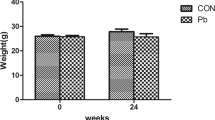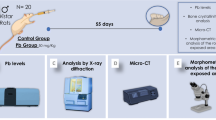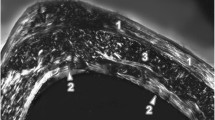Abstract
Lead chronic intoxication under hypoxic conditions revealed growth retardation in growing rats and damages on femoral and mandibular bones that predispose to fractures. These findings aimed us to investigate if bone material and geometric properties, bone mass in terms of histomorphometry or antioxidant capacity are also impaired in such experimental model. Combined treatments significantly reduced hemimandible cross sectional geometry and intrinsic stiffness (−16 % and −34 %); tibia and hemimandible bone volume (−45 % and −40 %) and growth plate cartilage thickness (−19 %). These results show a previously unreported toxic effect of lead on mandible however, longer studies should be necessary to evaluate if an adaptation of bone architecture to maintain structural properties may occur and if the oxidative stress can be identified as the primary contributory agent in the pathogenesis of lead poisoning.




Similar content being viewed by others
References
Bozzini C, Olivera MI, Huygens P, Alippi RM, Bozzini CE (2009) Long-term exposure to hypobaric hypoxia in rat affects femur cross-sectional geometry and bone tissue material properties. Ann Anat 191:212–217
Conti MI, Terrizzi AR, Lee CM, Mandalunis PM, Bozzini C, Piñeiro AE, Martínez MP (2012) Effects of lead exposure on growth and bone biology in growing rats exposed to simulated high altitude. Bull Environ Contam Toxicol. doi:10.1007/s00128-012-0602-2
Dosek A, Ohno H, Acs Z, Taylor AW, Radak Z (2007) High altitude and oxidative stress. Respir Physiol Neurobiol 158(2–3):128–131
Ercal N, Gurer-Orhan H, Aykin-Burns N (2001) Toxic metals and oxidative stress part 1 mechanisms involved in metal-induced oxidative damage. Curr Top Med Chem 1:529–539
Esteva S, Pedret R, Fort N, Torrella JR, Pagès T, Viscor G (2010) Oxidative stress status in rats after intermittent exposure to hypobaric hypoxia. Wilderness Environ Med 21(4):325–331
Ferretti JL (1997) Biomechanical properties of bone. From osteoporosis and bone densitometry. Springer, Berlin, pp 143–161
Ferretti JL, Cointry GR, Capozza RF, Capiglioni R, Chiappe MA (2001) Analysis of biomechanical effects on bone and on the bone muscle interactions in small animal models. J Musculoskel Neuron Interact 1:263–274
Galleano M, Aimo L, Puntarulo S (2002) Ascorbyl radical/ascorbate ratio in plasma from iron overloaded rats as oxidative stress indicator. Toxicol Lett 133:193–201
Hamed EA, Meki AR, Abd El-Mottaleb NA (2010) Protective effect of green tea on lead-induced oxidative damage in rat’s blood and brain tissue homogenates. J Physiol Biochem 66(2):143–151
Hamilton JD, O’Flaherty EJ (1994) Effects of lead exposure on skeletal development in rats. Fundam Appl Toxicol 22(4):594–604
Haschek WM, Rousseaux CG, Wallig MA (2010) Bone toxicity. In: Fundamentals of toxicologic pathology, 2nd edn. Academic Press, imprint of Elsevier Inc., Typeset by Macmillan Publishing Solutions
Lawton LJ, Donaldson WE (1991) Lead-induced tissue fatty acid alterations and lipid peroxidation. Biol Trace Elem Res 28:83–97
Lyn Patrick ND (2006) Lead toxicity part II: the role of free radical damage and the use of antioxidants in the pathology and treatment of lead toxicity. Altern Med Rev 11(2):114–127
Martínez MP, Bozzini C, Olivera MI, Dmytrenko G, Conti MI (2011) Aluminum bone toxicity in immature rats exposed to simulated high altitude. J Bone Miner Metab 29(5):526–534
Mosier HD (1969) Allometry of body weight and tail length in studies of catch-up growth in rats. Growth 33:319–330
Piehl LL, Facorro GB, Huarte MG, Desimone MF, Copello GJ, Díaz LE, Rubín de Celis E (2005) Plasmatic antioxidant capacity due to ascorbate using TEMPO scavenging and electron spin resonance. Clin Chim Acta 359:78–88
Shukla D, Saxena S, Jayamurthy P, Sairam M, Singh M, Jain SK, Bansal A, Ilavazaghan G (2009) Hypoxic preconditioning with cobalt attenuates hypobaric hypoxia-induced oxidative damage in rat lungs. High Alt Med Biol 10(1):57–69
Wright BM (1964) Apparatus for exposing animals to reduced atmospheric pressure for long periods. Brit J Haemat 10:75
Acknowledgments
The authors acknowledge the collaboration of physiology laboratory technicians Graciela M. Champin and Elsa Lingua, Department of Physiology, School of Dentistry, University of Buenos Aires. This work was supported by research grants from University of Buenos Aires (UBACyT 20020090200013).
Author information
Authors and Affiliations
Corresponding author
Rights and permissions
About this article
Cite this article
Conti, M.I., Bozzini, C., Facorro, G.B. et al. Lead Bone Toxicity in Growing Rats Exposed to Chronic Intermittent Hypoxia. Bull Environ Contam Toxicol 89, 693–698 (2012). https://doi.org/10.1007/s00128-012-0753-1
Received:
Accepted:
Published:
Issue Date:
DOI: https://doi.org/10.1007/s00128-012-0753-1




